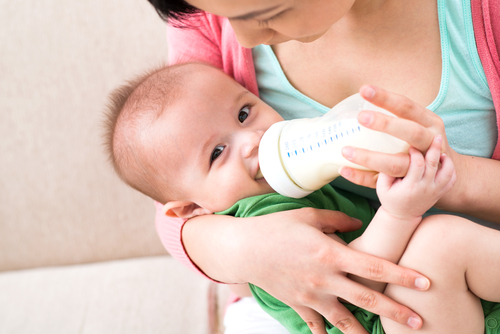5 Safety Tips for Bottle Feeding Baby
While many doctors advise that breastfeeding is the ideal feeding method for babies, that doesn’t mean that you’re required to do so. There are many reasons not to breastfeed, whether you personally prefer not to or are unable. Every mother is different, and there’s nothing wrong with turning to the bottle. This is especially true with the newest advances in nipple comfort and safety standards. Here are five essential tips on how to safely feed baby from a bottle. While many doctors and trained lactation consultants advise that breastfeeding is the ideal feeding method for babies, that doesn’t mean that you’re required to do so.
1. Holding and Feeding Baby
When you’re bottle feeding, you’ll need to make sure that you hold your baby the right way. Today’s Parent advises that you should hold the baby in a position where they can see your face and watch for signs that a break in feeding is necessary. Your baby should always have to suckle to get milk since this means they still want to eat. Also be aware that the nipple you’re using allows milk to flow at a steady pace, so your child isn’t overwhelmed with too much formula at once. For instance, Honest baby bottles fitted with specially designed peristaltic nipples facilitate a wave motion that closely resembles the sensation of breastfeeding.
2. The Dos and Don’ts of Formula
As an adult, it’s customary to store leftovers in plastic containers in the refrigerator for later use. Nothing tastes better than a leftover casserole when you’re exhausted at the end of the day and don’t feel like cooking. However, baby formula is a totally different situation. According to WebMD, you should never store breast milk or formula in plastic bottles. Instead, only use the bottle for feeding, and discard any leftover formula. Every time you feed the baby, you’ll need to prepare brand new formula. Otherwise, bacteria can grow very rapidly within only a few hours of leftover formula being retained. Even if your core philosophy is ‘waste not, want not,’ you’ll need to get used to the sensation of throwing out the unused formula. While you can conserve resources in other ways, such as using cloth diapers or turning towels into burp cloths, some baby things will simply need to be discarded.
3. How to Handle Feeding Equipment
Hygiene should be your number one priority when it comes to preparing formula and handling feeding equipment such as nipples and bottles. Healthy Women advises that you should keep formula powder dry by avoiding placing any wet utensils, such as spoons, into the mixture. You should also never microwave bottles, use a new nipple or bottle unsterilized, or administer formula with unwashed hands. The first step in preparing to feed baby should be a thorough hand washing. You can also prevent bacteria from accumulating by buying silicone bottles that are made from non-porous plastic. While many parents might prefer glass bottles, sticking to plastic is also a good way to avoid broken glass or other potentially harmful accidents. Babies can be fussy, and the last thing you want to do is drop a bottle during feeding time.
4. FDA Regulations and Safety Updates
The FDA banned the use of BPA in 2012 in children’s sippy cups and baby bottles due to consumer concerns, according to The New York Times. They note that containers made with BPA are marked with a seven on the bottom to indicate the type of plastic for recycling. If you inherited any baby bottles from family members or friends, it might be a good time to throw them out. Even if you don’t see the seven, standards of safety for baby items continue to increase every year. Due to the fact that babies and young children are some of the most vulnerable populations when it comes to potentially harmful chemicals, it’s always good to ensure that your feeding supplies are brand new.
5. Opportunity to Bond with Baby
Just because you’re not breastfeeding doesn’t mean that you can’t still reap some of the bonding benefits that come along with the process. For example, What to Expect suggests that an excellent way to bond with baby while bottle feeding is to take off your shirt to maximize skin to skin contact, a move that elevates the oxytocin, otherwise known as the love hormone. This is an ideal way to foster that same bond while still being able to use a bottle in your feeding routine. Interacting with baby using your voice, touch, and other tactile sensations is what builds the parent-child relationship in some of the most effective ways. By ensuring skin to skin contact while bottle feeding, you’re maximizing the opportunity to continue developing that bond at all times.
Safely bottle feeding baby is easier than ever, with a variety of different bottle and nipple options, as well as enhanced safety standards in place. By knowing how to read your child’s signals of when they’re finished eating and choosing top notch equipment, by the time they’re ready for solid foods, they’ll be healthy and happy.

















Thanks for sharing, This will definitely be helpful for me in the future.
Although I plan on breastfeeding, these are some good tips to know.
Good tips for anyone who is unable to breasfeed